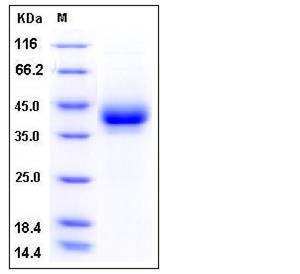Mouse CD209B / DC-SIGNR1 Protein (His Tag)
1810030I22Rik,DC-SIGNR1,mSIGNR1,OtB7,SIGNR1
- 100ug (NPP3491) Please inquiry
| Catalog Number | P50486-M07H |
|---|---|
| Organism Species | Mouse |
| Host | Human Cells |
| Synonyms | 1810030I22Rik,DC-SIGNR1,mSIGNR1,OtB7,SIGNR1 |
| Molecular Weight | The recombinant mouse CD209B comprises 268 amino acids and predicts a molecular mass of 31.4 kDa. As a result of glycosylation, the apparent molecular mass of mouse CD209B is approximately 40 kDa in SDS-PAGE under reducing conditions. |
| predicted N | His |
| SDS-PAGE |  |
| Purity | > 95 % as determined by SDS-PAGE |
| Protein Construction | A DNA sequence encoding the extracellular domain of mouse CD209B isoform 1 (NP_081248.2) (Gln 74-Gly 325) was fused with a polyhistidine tag at the N-terminus. |
| Bio-activity | |
| Research Area | Immunology |Signal Transduction |Cytoskeleton / ECM |Cell Adhesion |Lectin |C-tyep lectin | |
| Formulation | Lyophilized from sterile PBS, pH 7.4 1. Normally 5 % - 8 % trehalose, mannitol and 0.01% Tween80 are added as protectants before lyophilization. Specific concentrations are included in the hardcopy of COA. |
| Background | The cluster of differentiation (CD) system is commonly used as cell markers in immunophynotyping. Different kinds of cells in the immune system can be identified through the surface CD molecules which associating with the immune function of the cell. There are more than 320 CD unique clusters and subclusters have been identified. Some of the CD molecules serve as receptors or ligands important to the cell through initiating a signal cascade which then alter the behavior of the cell. Some CD proteins do not take part in cell signal process but have other functions such as cell adhesion. CD209b, also known as SIGNR1, is a C-type lectin receptor. CD209b is present on most regions of mouse brain and found on microglia and dendritic cells but not on neurons or astrocytes. CD209b is implicated in the recently described SIGNR1 complement activation pathway, which operates against capsular polysaccharides in splenic marginal macrophages. CD209b in rat is homologue to SIGNR1 in mouse, both of which are found to mediate the uptake of dextran or CPS14 within the splenic marginal zone. |
| Reference |
